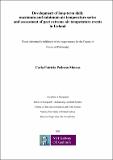| dc.description.abstract | Despite the rich heritage of meteorological observations registered in Ireland, prior to this PhD research, numerous historical daily air temperature records remained only in paper data sources across multiple archives, which constituted an obstacle to climate research. The assessment of the long-term frequency, duration, intensity, and distribution of extreme air temperatures events such as cold waves and heat waves in Ireland was lacking. Previous research on extreme air temperatures events has focused on the period with available digital daily air temperature observations, generally from the 1950s onwards, despite the rich heritage of continuous records from the 19th century. The extension of the temporal and spatial network dataset of long-term daily minimum and maximum air temperatures series dating back to the 19th century is crucial to a greater understanding of past climate variability and trends in Ireland.
Historical daily maximum and minimum air temperatures observations for 21 short-term series and 12 long-term series and registered in the period 1831 – 1968 were digitised from handwritten registers, newspapers, articles, proceedings, and monographs. The historical data were double keyed to avoid errors during the digitisation. Secondary school students (transition year), university students as part of an assignment, university students through the volunteering programme ALIVE, and members of the Irish Meteorological Society were engaged in the digitisation of historical data. A semi-automatic quality control procedure was employed. Doubtful maximum and minimum air temperature series were automatically flagged in R software through the application of statistical tests: climate consistency, internal consistency, day-to-day step-change, and persistence. The flagged data were manually assessed with the cross-reference of data and metadata. The homogenisation of daily, monthly, seasonal, and annual data in the period 1885 – 2018 was achieved through the application of the software MASHv3.03 (Multiple Analysis of Series for Homogenisation). The assessment of frequency, duration, intensity, and distribution of air temperatures extremes recommended by the World Meteorological Organization Expert Team on Climate Change Detection and Indices was made through R software. The assessment of heat waves and cold waves was supported by the cross-reference of documentary supporting information.
The rescued daily maximum and minimum air temperatures series for 21 short-term and 12 long-term series and station metadata in the period 1831 – 1968 are available as open access (Mateus et al., 2020). Secondary school students-scientist partnerships as part of service-learning have the potential to be applied elsewhere and contribute to a fast, accurate, and efficient climate data rescue process (Mateus et al., 2021). The rescued historical data presented quality issues (errors and outliers) such as climate consistency, internal consistency, persistence, and day-to-day step-change, which were corrected through statistical quality control procedures, and analysis of documentary sources and metadata. Changes in the station location and surroundings, instrumentation, and observation practices introduced non-climate inhomogeneities in the air temperature data, which were removed through the application of statistical homogenisation procedures in combination with the analysis of station metadata.
The findings of this research follow state of the art for Europe, assessing a significant decrease in the number of frost days and cold days, increase in the number of summer days and warm nights. Heat waves are increasing in frequency and intensity in the 2nd half of the 20th century. Using the Met Éireann’s definition, the most intense heat waves are only seen from the 1970s onward in stations such as Markree, Phoenix Park Dublin, and Valentia Observatory. Following state of the art on European trends, the frequency and intensity of cold waves are decreasing, although the cold wave of December 2010 was one of the most intense events in the instrumental record.
The assessment of past extreme air temperatures events is important to assist stakeholders and policymakers in defining climate action, adaptation and mitigation policies, and reducing the vulnerabilities of future extreme events. A greater understanding and reduction of vulnerability is necessary to mitigate the demographic, environmental, and socio-economic impacts of future extreme air temperatures events. | en_IE |


